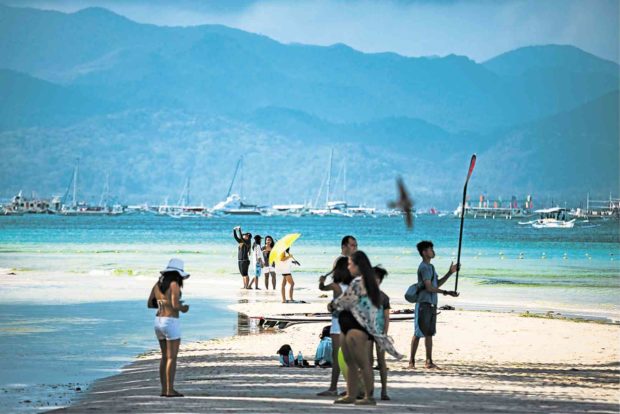Town gov’t accepts Boracay ‘cesspool’ tag as ‘constructive criticism’

Boracay Island in Aklan province remains one of the top tourist-drawing destinations in the Philippines. (File photo by JILSON SECKLER TIU / Philippine Daily Inquirer)
ILOILO CITY — Finally breaking its silence, the Malay municipal government in Aklan on Monday described President Rodrigo Duterte’s calling of Boracay Island as a “cesspool” as “constructive criticism” and offered its “full cooperation” to the six months deadline set by the President to address the island’s environmental problems.
But in an official statement, the first in 10 days since the President lambasted the environmental situation of the island, the Malay local government unit hit news reports showing images of algal bloom coating Boracay’s beaches.
The Malay officials said measures were being taken to address the environmental problems of the 1,032-hectare island.
Boracay is part of Malay town in Aklan province at the northern tip of the Panay Island.
Three of the town’s 17 villages of the town are in Boracay.
Article continues after this advertisement“The Local Government recognizes the existence of these problems and its responsibilities in order to uphold the environmental and social welfare of our beloved island,” the officials said in the statement.
Article continues after this advertisementThey cited a contract signed late last year by the municipal government with top architectural firm Palafox Associates to formulate and implement a municipal tourism master plan.
Part of the plan is to decongest Boracay by integrating the mainland of Malay in the development of Boracay.
The officials also cited efforts to do the following:
- pursue and prosecute violators of the 30-meter beach setback
- organize a task force to rehabilitate and maintain the beauty of Bulabog Beach at the eastern side of the island
- clear residual trash from the island’s central material recovery facility
- strictly implement the construction of sewage treatment plant in establishments
They said they “recognize that the President is not happy with what is happening (on) Boracay Island” despite these efforts.
“We do accept the constructive criticisms of our President and use it as the fundamental aspect of our improvements,” the officials said.
The local government said it will work closely with national government agencies to meet the President’s deadline, stressing the importance of the assistance of the national government to address the problems.
The local government unit will release this week a six-month action plan and convene of the existing municipal waste water management council and Bulabog Task Force to help in the implementation of the plan.
But the officials criticized television networks ABS-CBN and GMA for showing photos “sensationalizing the algal phenomenon” in Boracay.
According to the local government, the algal bloom happens only during summer.
“We condemn the recycling of photos for the selling of their ‘news.’ These news institutions gain profit from their news that ultimately degrades the image of Boracay Island which is highly dependent on the tourism industry. We advocate for responsible journalism,” the officials said in its statement.
Many business operators and residents have claimed that the algal blooms are seasonal, “natural,” and have been occurring even before the island became developed.
But environmentalists and even some long-time residents have raised warnings that the bloom is an indication of deteriorating water condition and of pollution.
In 2015, then Environment Secretary Ramon Paje noted that the algae bloom along the Boracay shoreline indicated water pollution resulting from “poor waste management with sewage being dumped into the waters.”
In a press statement issued on May 4, 2015, the Department of Environment and Natural Resources cited a study by conservation group Global Coral Reef Alliance that “the presence of green algae along Boracay’s shoreline during the calm season is a strong indicator of very high nutrient pollution that they are typically found right around sewage outfalls.”
In that statement, the DENR said the algae “die back in the rough season because waves dilute nutrients to lower levels and wash away the algae and the suspended sediments reduce the light levels. The algae become visible again in the next calm season.”
But the Malay municipal government said the media was “sensationalizing the algae phenomenon which ultimately hurts the industry of Boracay.”
“We can expect that the algae season will still happen during the summer of this year – and we are prepared for another barrage of news claiming that Boracay is ‘dirty’,” the statement said. /atm